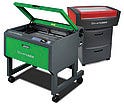March 6, 2009
Originally Published MPMN March 2009
FOCUS ON EQUIPMENT
Printing and Surface Treatment
Parylene Coating System Produces Lubricious Surface
Click to enlarge |
Available in benchtop and large-scale models, an automated vacuum deposition system treats a variety of substrates using parylene to create an ultrathin, pin-hole-free, hydrophobic surface. In addition to enhancing lubricity, the coating acts as a moisture and chemical barrier. It also provides electrical insulation, biocompatibility, optical clarity, and high mechanical strength. Suited for such medical devices as implantable components, prosthetics, needles, catheters, and electrodes, the coating is not subjected to cure stress, elevated temperatures, or solvents. The system's coating cycle begins with vaporization of the powdered raw coating material. Once in gas form, the molecules are dispersed; they then polymerize on device surfaces to form the thin coating film. Because the process does not include a liquid phase, the coating will not pool in low areas or exhibit other liquid properties, such as meniscus or capillary action.
Para Tech Coating Inc., Aliso Viejo, CA
www.parylene.com
Digital Ink-Jet Printer Features Large Flatbed
Click to enlarge |
Customizable for in-line applications, a digital ink-jet printing system has a flatbed that accommodates 400-, 600-, and 1000-mm platforms. The Rapid Fire 1001 features an Xaar 1001 printhead and is designed to offer increased speed and accuracy compared with nondigital systems. Capable of printing high-quality monochromatic images at 21 in./sec, the system can handle bar coding, sequential numbering, and on-the-fly product marking and decoration operations. Using its gantry conveyor systems, vision controllers, and articulated robotic arms, the printer can be integrated with such automation systems as conveyorized linear shuttles, rotary tables, and pre- and posttreatment and packaging processes. A version of the system with full-color capabilities is currently in development.
Pad Print Machinery of Vermont, East Dorset, VT
www.padprintmachinery.com
Laser Systems Mark Metals without Compounds
Click to enlarge |
Using high-power density focusing (HPDF) optics, a line of CO2 laser systems can permanently mark directly onto metal medical devices without the use of metal-marking compounds. The VersaLaser line employs HPDF optics to achieve improved resolution for applications requiring detailed engraving or fine cutting. Using a materials-based print driver that allows for quick, user-friendly operation, the systems can handle a range of metals, including stainless steel, chrome steel, and titanium. Available in three platform sizes, the series offers laser power up to 60 W and work areas measuring up to 32 × 18 in. Also compatible with industry-standard coding and labeling software, the systems are offered in red, blue, green, yellow, and purple versions.
Universal Laser Systems Inc., Scottsdale, AZ
www.ulsinc.com
Coating System Is Designed for Combination Products
Click to enlarge |
Designed to meet the coating integrity and reproducibility requirements for combination devices, a system accommodates tubular devices, such as stents, planar structures, and other medical implants. Critical process parameters of the Emendo system are controlled to ensure batch-to-batch consistency using process analytical technology. Alignment of a device or multiple devices is performed with precision to ensure consistent coating results. The minimal contact area between the secure support mechanism and the device being treated helps to prevent coating defects and enables more-even coating of complex structures.
ioos systems LLC, San Diego
www.ioossystems.com
For more features and articles on surface treatment, go to devicelink.com/mpmn/surface
Copyright ©2009 Medical Product Manufacturing News
You May Also Like




